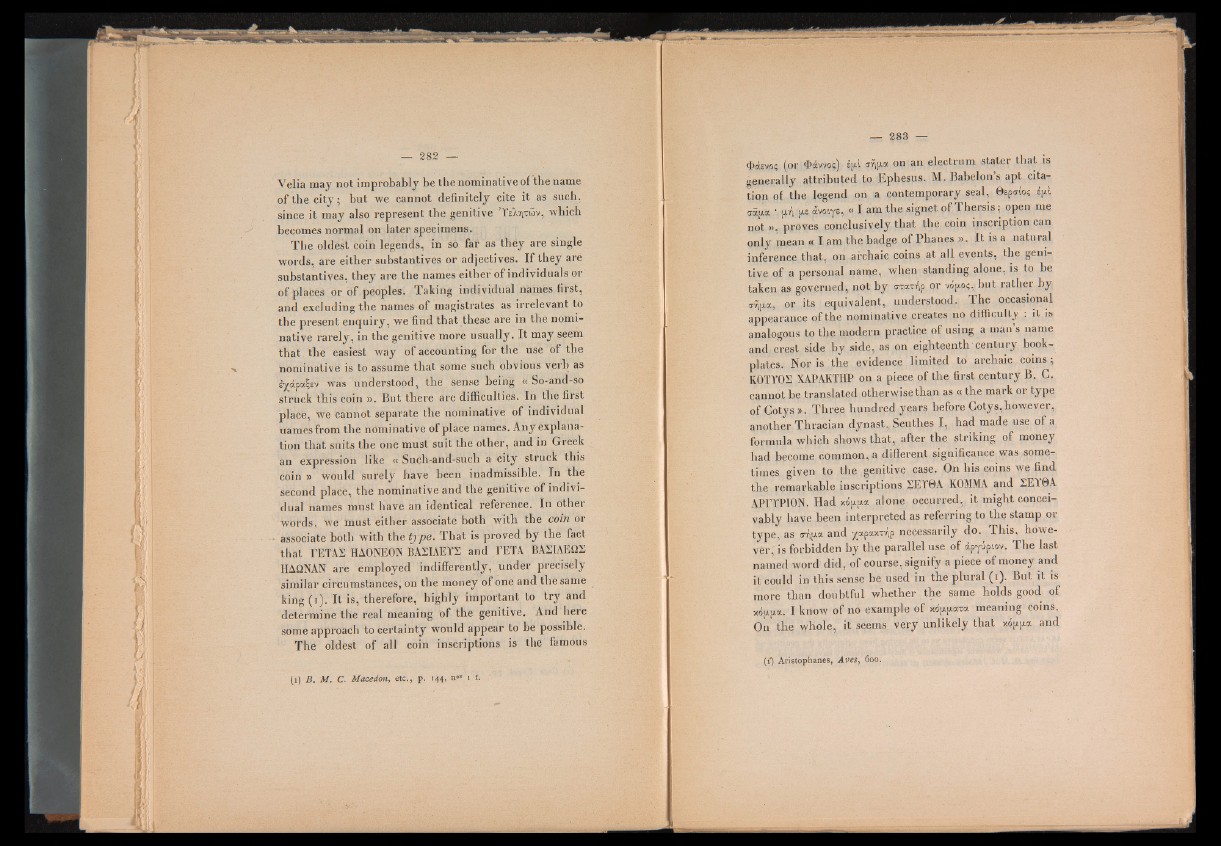
Velia may not improbably be the nominative of the name
of the c ity ; but we cannot definitely cite it as such,
since it may also represent the genitive ’Ye),r,Tuv, which
becomes normal on later specimens.
The oldest coin legends, in so far as they are single
words, are either substantives or adjectives. If they are
substantives, they are the names either of individuals or
of places or of peoples. Taking individual names first,
and excluding the names of magistrates as irrelevant to
the present enquiry, we find that these are in the nominative
rarely, in the genitive more usually. It may seem
that the easiest way of accounting for the use of the
nominative is to assume that some such obvious verb as
l^apaqev was understood, the sense being « So-and-so
struck this coin ». But there are difficulties. In the first
place, we cannot separate the nominative of individual
uamesfrom the nominative of place names. Any explanation
that suits the one must suit the other, and in Greek
an expression like « Such-and-such a city struck this
coin » would surely have been inadmissible. In the
second place, the nominative and the genitive of individual
names must have an identical reference. In other
words, we must either associate both with the coin or
- associate both with the type. That is proved by the fact
that TETAS HAONEON BASIAETS and TETA BA2IAEQE
HAQNAN are employed indifferently, under precisely
similar circumstances, on the money of one and the same
king (i). It is, therefore, highly important to try and
determine the real meaning of the genitive. And here
some approach to certainty would appear to be possible.
The oldest of all coin inscriptions is the famous
(i) B. M. C. Macedón, etc., p. 144, n»* 1 1.
<f>aevo; (or <f>avvo<;) ¿pu on an electrum stater that is
generally attributed to Ephesus. M. Babelon’s apt citation
of the legend on a contemporary seal, 0epo,io; Jpl
ijapa • pri pee avotyg, « I am the signet of Thersis: open me
not »>, proves conclusively that the coin inscription can
only mean « I am the badge of Phanes ». It is a natural
inference that, on archaic coins at all events, the genitive
of a personal name, when standing alone, is to be
taken as governed, not by orar/jp or vopo;, but rather by
ir-zipa, or its equivalent, understood. The occasional
appearance of the nominative creates no difficulty : it is
analogous to the modern practice of using a man’s name
and crest side by side, as on eighteenth century bookplates.
Nor is the evidence limited to archaic coins;
KOTYOE XAPAKTHP on a piece of the first century B. C.
cannot be translated otherwise than as « the mark or type
of Cotys ». Three hundred years before Cotys,however,
another Thracian dynast, Seuthes I, had made use of a
formula which shows that, after the striking of money
had become common, a different significance was sometimes
given to the genitive case. On his coins we find
the remarkable inscriptions EEY0A KOMMA and EEYQA
APITPION. Had xoppia alone occurred, it might conceivably
have been interpreted as referring to the stamp or
type, as 3 ' ' and yapax~f|p necessarily do. This, however,
is forbidden by the parallel use of apyupiov. The last
named word did, of course, signify a piece of money and
it could in this sense be used in the plural (1). But it is
more than doubtful whether the same holds good of
xoppia. I know of no example of xdppara meaning coins.
On the whole, it seems very unlikely that xoppa and
(A Aristophanes, A ves, 600.